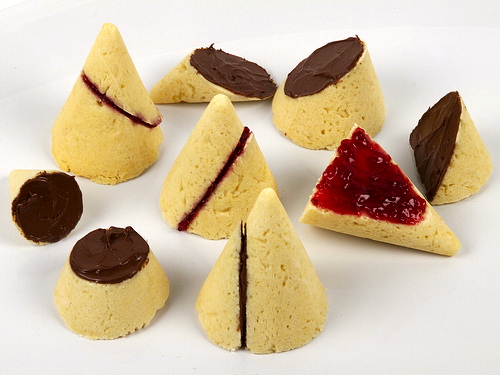Following on yesterday’s edible-penguin posting (focused mostly on cookies and chocolates), I return today to phallic foodstuffs, a topic last discussed here in connection with penis-shaped breadstuffs: baguettes, brioches, and tartes. Now to cookies and chocolates, with the nice portmanteau find cockie ‘cock cookie’, plus some other deliberately phallic food.
The find of cockie was on this site, which has a recipe for making the cookies (but not very good photos). There are probably more hits out there, but various factors interfere with searches, most notably cockie as a frequent misspelling of cookie. But there’s also cocky (with the variant cockie), Australian slang for ‘cockatoo’; cocky (with the variant cockie), Australian slang for a type of small-scale farmer; and cock-a-leekie soup (with the variant cockie leekie), a Scottish soup dish of leeks and chicken stock.
But there are plenty of other penis cookies out there. Here are two varieties, an easy home recipe and a fancier (and more realistic) item:
There are penis cookie cutters out there of several sorts, for cookies like #1 and for cookies with a side view, as in this set from Bachlorette:
 (#3)
(#3)
A joke eCard about penis cookies:
 (#4)
(#4)
Then to chocolates. Again, an enormous variety, from the relatively simple (and realistic):
 (#5)
(#5)
to the imaginatively artistic:
8″ Of Chocolate
The first product from new erotic brand United Indecent Pleasures is an eight-inch chocolate penis that oozes fondant cream.
The filling comes in six fruit and liqueur flavours, and there’s a firmer chocolate fondant in the base. (link)
(Chocock would be a plausible portmanteau for ‘chocolate cock’, but it doesn’t seem to be attested.)
Somewhat further afield to chocolate penis peanut brittle, which it’s hard not to think of as penis brittle:
With penguins, I moved on from sweet things to crackers. Though there are plenty of penguin-shaped crackers for sale, I haven’t found any penis-shaped ones. Instead, for penis crackers we find crackers with outlines of penises on them, like these Triscuits and Easy Cheese numbers:
On Easy Cheese, from Wikipedia:
Easy Cheese is the trademark for a processed cheese product distributed by Mondelēz International, also referred to as aerosol cheese, spray cheese or simply Cheese in a Can, and is a descendant of squeeze cheese (a semi-solid cheesefood from the 1970s packaged in a squeezable plastic tube). It comes packaged in a pressurized can, much like canned whipped cream and does not require refrigeration. Easy Cheese has its own entry in [Jane and Michael Stern’s] Encyclopedia of Bad Taste. It was originally marketed from 1965-84 as Nabisco Snack Mate.
Going further afield from penis crackers, we get to penis pasta:
 (#9)
(#9)
and to the entertaining sushi penis:
 (#10)
(#10)
Many ways in which you can actually eat a metaphorical penis (as opposed to metaphorically eating an actual penis, in fellatio).
Two Bonuses. Searching for images of food in the shape of a penis pulled up several non-food examples of phallicity, among them these astonishingly realistic penis bottle openers:
 (#11)
(#11)
and this suggestive cologne bottle in a 1979 Pierre Cardin ad:
 (#12)
(#12)
The items in #11 are jokes, like the penis-shaped food. But #12 is intended to convey a sense of intense masculinity for the product, as if wearing this cologne will make you more of a man.









 (#4)
(#4)













































